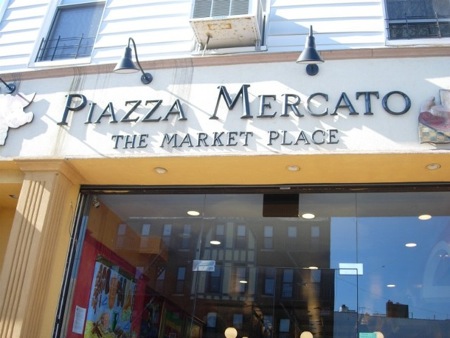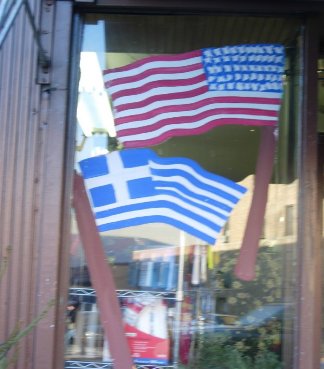Bay Ridge- Here v. There
From Decoding New York
| Introduction |
| The East Village |
| * Evolution |
| * Here v. There |
| * Economy |
| * What's Real |
| Bay Ridge |
| * Evolution |
| * Here v. There |
| * Economy |
| * What's Real |
| Comparison |
| * Photo Gallery |
| * Sources
|
The sweet aroma of fruit tobacco and steaming Arabic coffee lingers temptingly on the busy avenue, drawing in all ethnicities to the array of Lebanese cafés that line the street. Nearby, the Egyptian market displays signs in Arabic advertising Halal meat, and just a few blocks away, the Piazza Mercado boasts a wide variety of Sicilian cheeses and salamis. Like many New York City neighborhoods, Bay Ridge is shaped socially and economically by its inhabitants' ethnic cultures. Yet, unlike other areas that are molded after a single country—Chinatown, Washington Heights, Brighton Beach—Bay Ridge is a unique blend of similar cultures that have fused together in Southern Brooklyn. By incorporating aspects of Lebanese, Egyptian, Syrian, and Moroccan traditions, this neighborhood is defined by many as being “Arab”, yet it does not attempt to recreate the “old country” because its populace do not all hail from one place. While many of the shops stay true to their culture, oftentimes placing their native flags outside the window, the Arab community here seems to be assimilated not so much to American culture, but more so to the other Arab cultures. Concentrated heavily on Fifth Avenue, this community has become a melting pot for different Middle Eastern cultures that have, as a result, come together creating an environment that is perhaps unique to New York City and unlike any one country in Eurasia.
This trend can be observed also with the longer-standing Italian community in Bay Ridge as well. Generally, Italians have assimilated to American culture more than their Arab neighbors because of their earlier migration. However, based on their heavy cultural presence in this neighborhood, it is obvious that they still hold on to their roots and may consider themselves only 'hyphenated Americans'. Like the Arabs, the Italians embrace their cultural differences not only from other Americans but also from each other, distinguishing between Sicilian and other regional Italian groups. In the restaurants, markets, cafes, and butcher shops that mainly line Third Avenue, any Italian worker inside answers the question “Where are you from?” by a specific region of Italy rather than the country. These differences can be tasted in the distinct dishes of Bay Ridge’s many restaurants.
The extent to which Bay Ridge’s population is assimilated depends entirely upon the ethnicity. The earlier immigrants, the Irish and Scandinavian, are virtually completely assimilated. Once the predominant groups of this neighborhood, these cultures today only have one store each that is native to their heritage, in which ethnic foods, newspapers, and books are sold. Aside from the many pubs that bear Irish names, though, their cultural presence here is slight, leading one to assume that they have completely assimilated. Italians and Greeks, who essentially dominated the second wave of immigration to Bay Ridge, have assimilated to a lesser extent than their predecessors, but considerably more than the Arabs that more recently arrived. While there is no one particular area dominated by Italian or Greek culture, their influence is dispersed throughout and is definitely significant. Signs in Greek advertising schools, pharmacies, supermarkets, and even thrift stores, are not uncommon in this area, not to mention the many Greek restaurants on both Third and Fifth Avenues. Similarly, Italian culture is also strong, with the Italian flag displayed all across Third Avenue in front of many small businesses and restaurants.
In contrast, Bay Ridge’s most recent immigrants—Arabs—have yet to considerably assimilate to American culture. Unlike the other ethnic groups, the Arab community is essentially concentrated into a particular area of this neighborhood (Fifth Avenue), making their presence even more powerful. This separation is accountable for several reasons, the most obvious being language barriers and religious differences. For example, businesses run by Italians may have an Italian flag outside but they advertise in English and therefore receive a wide variety of customers, seeing as they target a broader range of people. Arab-run businesses, however, ranging from tax attorneys to doctors’ offices, generally have signs in Arabic that are targeting a specific group of people, thus isolating non-Arabic speaking citizens. Accordingly, non-Arabs do not usually shop at Arab stores, yet they do frequent European stores run by ethnicities other than their own. Indeed, the only significant interaction occurring between Arabs and non-Arabs seems to be in restaurants, where different foods bring together people of diverse ethnicities regardless of any language or religious barriers.
Secondly, and perhaps more importantly, religious differences account greatly for the lack of interaction between these two broad groups. While the European immigrants of the past had definite ethnic differences, they were all generally united by Christianity, unlike many of Bay Ridge’s newest residents. Thus, stores that advertise Halal meat and hair salons that accommodate for women wearing traditional hjab (Islamic headscarves), are frequented only by Arab Muslims. Perhaps in the future there will be a greater effort by the Arab community to branch out and communicate with other ethnicities. For the time being, though, it does not seem as though Bay Ridge’s peacefully co-existing ethnic communities are going to interact any more than necessary.


